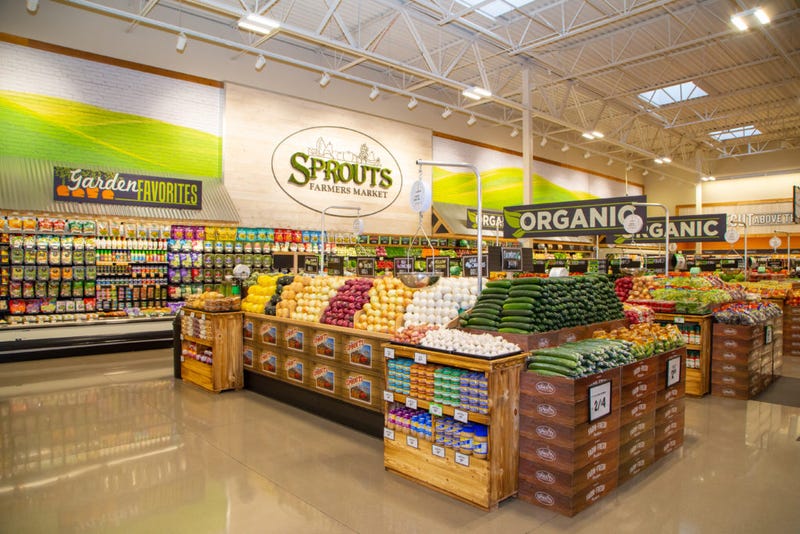Sprouts Farmers Market reexamines marketing strategy to increase sales
CEO Jack Sinclair says retailer’s recent efforts didn't meet expectations, but traffic increased during Q3
November 5, 2021

Natural retailer Sprouts Farmers Market failed to communicate its pricing strategy when it rolled out its new marketing plan this year, CEO Jack Sinclair told investors Thursday afternoon.
"We have the right strategy, and we are excited about moving it forward, piece by piece: making great progress on our supply chain; differentiated merchandise; new format; and real estate selections," Sinclair said after the company released its third-quarter earnings report. "However, our initial marketing messages fell short in a few areas. We fully expected to see a positive two-year stack in the back half of this year, and through the third quarter, we did not.
"With this in mind, we're focusing on delivering a clear message that highlights our sharp produce pricing, innovative products and a farmers-market experience to drive additional transactions in the quarters and years ahead," Sinclair said.
Comparable store sales in the third quarter, which ended Oct. 3, dropped 5.4% from the same period in 2020 and fell 2.1% compared with Q3 2019, the company reported.

Sprouts Farmers Market is focusing its message on how its produce differs from that available at other stores, its prices are lower than those of competitors and it offers more varieties of local organic foods.
Shortly after Sinclair took over as CEO in June 2019, Phoenix, Ariz.-based Sprouts transformed its strategy to attract new customers and become more profitable. Two key parts of the strategy were to end the extreme reducing of produce prices and to stop buying print and direct mail advertising, instead focusing on digital promotions.
As expected, store traffic dropped but margins improved, the CEO recalled. Then, in the first quarter of 2020, COVID-19 struck the U.S. and upended the grocery industry and how consumers shopped.
In the second quarter of 2020, Sinclair said, transactions dropped 25% — and haven't returned to their pre-pandemic level.
"Certainly COVID played a significant role in changing the shopping habits of our customers during the height of the pandemic. Additionally, our change in promotional approach resulted in the loss of coupon clippers," he said. He's encouraged, though, that the pre-pandemic customers who still shop at Sprouts — 75% of the company's shoppers — are buying more products than they did two years ago.
The company is changing its messaging to focus on how its produce differs from that available at other stores, its prices are lower than those of competitors, and it offers more varieties of local organic foods, Sinclair said. Store traffic increased each month during the third quarter, he added, and the team continues to test new messages.
Q3 financials
For the third quarter, Sprouts reported its financial results with comparisons to both fiscal 2020 and fiscal 2019:
Net sales of $1.5 billion were a 4% decrease from the same period in 2020 and a 5% increase from the same period in 2019.
Gross profit for the third quarter of fiscal 2021 was $540 million, a 7.7% decrease from the third quarter of fiscal 2020.
Gross profit margin was 35.8%, a decrease of 131 basis points, or 1.31%, from the same period in 2020. The margin was 265 basis points, or 2.65% higher, than the margin from the same period of 2019.
Net income of $64 million compared with net income of $60 million and adjusted net income of $62 million in Q3 2020. The adjustment, a calendar shift because 2020 had 53 weeks, was made to align holidays in the two years.
The $64 million net income also was compared with net income of $26 million from Q3 2019.
Diluted earnings per share of $0.56, compared to $0.51 diluted EPS and adjusted diluted EPS of $0.52 in 2020. Diluted EPS for Q3 2019 was $0.22.
Sprouts also released financial results for the first three quarters of the year, compared with the same period for 2020:
Net sales total $4.6 billion, a 5.6% decrease from $4.87 billion in 2020.
Gross profit was $1.7 billion, a 6.9% decrease from $1.8 billion in 2020.
Net income was $207.9 million, a 5.4% decrease from $219.1 million in 2020.
New CFO expresses optimism
Chip Molloy, a former Sprouts board member, was appointed chief financial officer effective Sept. 25, after Denise Paulonis left to become the CEO of Sally Beauty Holdings Inc. During the earnings call, he addressed his reasons for joining the executive suite.

"First and foremost, I love this company, its people and its purpose of providing healthy living options at reasonable prices," said Molloy (left). "Second, the stage has been set for future success. We have a differentiated customer experience with unique product offerings, and a new prototype that should allow us to aggressively expand our reach while creating shareholder value along the way.
"As we continue to learn more about those customers that love us and tell that message to those that don't know us, we will slowly but surely turn the corner on comp-store sales while still maintaining relatively stable margins," he continued.
Although Molloy said it was too soon to offer definitive expectations for 2022, he said Sprouts plans to open 25 to 30 new stores — a strong pipeline of leases and sites already exists — mostly likely during the fourth quarter. COVID-19 is affecting supply chains, as well as municipal improvements and developments. The retailer currently operates 362 stores in 23 states.

This article originally appeared on New Hope Network, a Supermarket News sister website.
About the Author
You May Also Like




